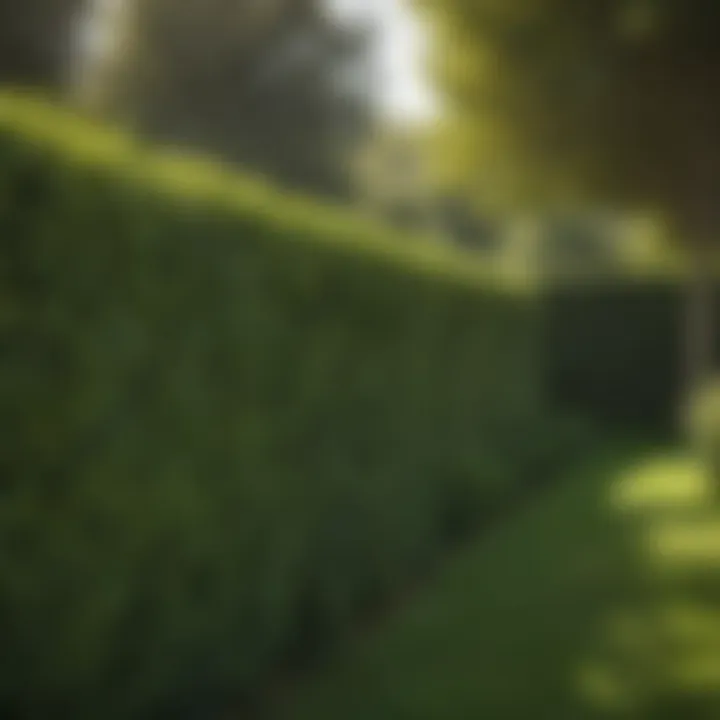Fast Growing Privacy Hedges for Every Season


Intro
Creating a private sanctuary within one’s own home is a desire that resonates with many. Fast-growing year-round privacy hedges serve as nature's answer to this longing, disguising your outdoor spaces from the prying eyes of neighbors while also beautifying your garden. Selecting the right hedges, implementing proper plant care strategies, and understanding how these elements meld into a cohesive landscape is integral to fostering that enclosed feeling of solitude.
The challenge, however, lies in understanding the myriad options available. From choosing the ideal species that thrive in your climate to learning how to integrate these greens harmoniously with your existing layout, it’s no small feat. In this piece, we unravel the essential components of establishing these living barriers so that your garden becomes a true extension of your home, alive with color and texture, yet fortified with seclusion.
Key Insights and Trends
Current Trends in Landscaping
Picking up from recent surveys and discussions on platforms like Reddit and Facebook, a growing number of homeowners are leaning toward sustainable gardening practices. Not only is this environmentally conscious, but it also leads to low-maintenance solutions which resonate well with busy lifestyles. Fast-growing hedges such as Leyland Cypress and Green Giant Arborvitae are becoming increasingly popular due to their resilience and rapid growth.
- Native plants: Using native hedges promotes biodiversity and minimizes water usage.
- Continuous flowering: Varieties that bloom in different seasons are gaining traction for their aesthetic appeal.
Popular Gardening Techniques
Gardeners are not merely planting shrubs anymore; they are strategically designing spaces. Here’s what’s trending:
- Layering: Employing hedges of varying heights to create depth and visual interest.
- Mixing textures: Combining different foliage types fosters a lush look that feels more dynamic.
Edifying oneself on these nuances can not only amplify your garden’s charm but also enrich your personal oasis.
Practical Tips and How-To Guides
Setting your sights on effective hedge planting requires a discerning approach. Here’s a systematic breakdown:
Step-by-Step Guide for Planting Hedges
- Choose your plants wisely: Research species suited for your hardiness zone. For example, in warmer climates, consider Southern Magnolia or Viburnum.
- Plan your layout: Sketching your garden's design can help visualize where each hedge will flourish without overcrowding.
- Prepare the soil: Ensure the natural drainage is adequate and amend the soil with organic matter to promote root growth.
- Planting: Dig holes twice as wide as the root ball but no deeper than the root base. Space them according to the mature width.
- Mulch: Applying a few inches of mulch conserves moisture and suppresses weeds.
- Watering: Initial watering is critical; maintain consistent moisture until plants establish.
Maintenance Practices
Once your hedges are thriving, ongoing care is essential:
- Regular Pruning: Shape hedges to promote dense foliage and control their height.
- Feeding: Periodic fertilization can encourage vigorous growth.
- Pest Management: Keep an eye on common pests, which can create havoc if left unattended.
"A well-manicured hedge can transform not just a yard but the feeling of entire property, crafting idyllic settings that embrace nature while providing privacy."
By tapping into these insights, readers can elevate their understanding of privacy hedges, ultimately crafting a garden that coddles them in seclusion while blossoming beautifully year-round.
Understanding the Need for Privacy Hedges
The quest for personal space has been a timeless endeavor for homeowners and garden enthusiasts alike. Privacy hedges have emerged as both functional and aesthetic solutions to creating secluded sanctuaries within properties. While some might regard them as mere rows of greenery, they serve a deeper purpose that intertwines comfort, security, and beauty.
Defining Privacy Hedges
At its core, a privacy hedge is a dense planting of shrubs or trees designed to block sightlines, delineate boundaries, and even dampen sounds. Unlike standard fences, which can feel rigid and impersonal, hedges bring life to the landscape. They act as a natural barrier, adaptable and inviting simultaneously.
In practical terms, privacy hedges can vary from a single row of fast-growing shrubs to multilayered trees that reach impressive heights. Common species include Thuja Green Giant, which is known for its swift growth and lush density, or the Emerald Green Arborvitae, valued for its compact form. These living walls not only provide sanctuary but also contribute to the overall ecological health of a garden by attracting beneficial wildlife.
Reasons for Installing Hedges
Homeowners choose to install privacy hedges for a myriad of reasons, blending enjoyment with functionality. Some of the primary motivations include:
- Enhancing Security: A well-placed hedge can deter unwanted attention, keeping prying eyes away from intimate gatherings or family activities. They offer a natural sense of security without the harshness of a traditional fence.
- Creating Outdoor Retreats: Hedges can transform a simple backyard into a cozy retreat. By shielding from the bustle of the outside world, they encourage relaxation and serve as an ideal space for gatherings and family events.
- Defining Property Lines: Often, unclear boundaries can lead to disputes. Hedges clearly mark property lines while still adding a layer of aesthetics.
- Noise Reduction: Depending on the species and density, hedges can absorb noise, providing a more tranquil environment – especially useful in urban settings where sounds of traffic can be intrusive.
- Environmental Benefits: Beyond the immediate human benefits, these plants foster a healthy ecosystem. They provide habitats for birds, pollinators, and other wildlife, contributing to the balance of local flora and fauna.
"Landscaping with privacy hedges is not just about creating boundaries; it's about crafting an experience that enriches a home."
In an age where the hustle and bustle can be overwhelming, the allure of privacy hedges is undeniable. They offer peace, safety, and a touch of nature, making them a must-consider aspect of garden design. The next sections will delve into how to choose the right species and how to care for these green guardians, ensuring that they flourish year-round.
Characteristics of an Ideal Privacy Hedge
When considering the installation of a privacy hedge, understanding its characteristics is paramount. These elements not only govern how effectively the hedge serves its purpose but also influence the long-term satisfaction of the homeowner. The right hedge can offer a sense of security, enhance landscaping aesthetics, and become a valuable asset to one’s property. Here, we examine three core characteristics of an ideal privacy hedge: growth rate, year-round foliage, and height and density considerations.
Growth Rate
The growth rate of a privacy hedge plays a crucial role in determining how quickly it can provide the desired level of seclusion. Fast-growing varieties are often sought after because they reduce waiting time for coverage. Consider a scenario where you want to block out a view or create a barrier; a slow grower like a holly might take years to offer adequate coverage. In contrast, a variety like Thuja Green Giant can grow up to three feet in a single season under optimum conditions.
With fast growth comes the need for diligence, however. Ideal hedges that flourish quickly do require more maintenance — regular watering, fertilization, and potentially, more frequent pruning to shape their desired form. Understanding this relationship between growth rate and care aids homeowners in setting realistic expectations and planning for the maintenance of their chosen hedges.
Year-Round Foliage
Having a hedge that offers year-round foliage is akin to wearing a coat that keeps you warm in winter; it’s totally essential for consistent privacy. Evergreens, for example, tend to be the go-to for those looking for uninterrupted greenery throughout all seasons. Trees and shrubs like Emerald Green Arborvitae maintain their foliage year-round, providing a screen against surrounding eyes, no matter the weather.
The visual appeal of a lush, green hedge in winter is significant. It not only serves as a functional barrier but also contributes to the overall beauty of your landscape. Imagine having a serene, uniform green backdrop in the cold months contrasted against stark, bare branches of deciduous plants. Clearly, a hedge with year-round foliage brings both functional and aesthetic advantages.
Height and Density Considerations
Height and density are critical factors when considering the implementation of a privacy hedge. An effective hedge must be tall enough to obstruct views while still aligning with the scale of the surrounding landscape. Hedges that are too short can leave gaps in privacy when they come under scrutiny from nearby homes or streets. Conversely, towering hedges, while potentially comprehensive in coverage, can lead to a sense of confinement, especially in smaller gardens.


In terms of density, a hedge should offer a solid barrier against sight lines while also being aesthetically pleasing. Dense hedges, such as a Privet, can effectively block distractions, while thinner varieties may not be suitable for those seeking full privacy. Finding the right balance between height and density is essential not only for maximizing privacy but also for ensuring that the hedge integrates well with your existing landscape.
"The right characteristics of a privacy hedge can enhance both functionality and the overall appearance of your landscape."
In summary, when selecting a privacy hedge, focus heavily on its growth rate, year-round foliage, and the considerations of height and density. Each of these factors contributes to the hedge's performance and its impact on your garden's beauty. By prioritizing these characteristics, homeowners can ensure they select a hedge that meets both practical needs and aesthetic desires.
Selecting the Right Plant Species
Choosing the right plant species for privacy hedges is a vital step in ensuring your garden not only looks great but also serves its purpose effectively. The right selection directly influences factors such as growth rate, maintenance needs, and overall aesthetic appeal. A well-chosen hedge can provide the seclusion you crave while complementing the landscape of your home. Not all plants are created equal; understanding their specific traits and your environment will help you avoid costly mistakes down the line.
Popular Fast-Growing Varieties
Thuja Green Giant
Thuja Green Giant stands out for its rapid growth and impressive height. This evergreen can quickly reach a height of 40 to 60 feet when planted in the right conditions, making it a go-to choice for homeowners looking to create a high hedge. Its dense foliage fosters a natural barrier against prying eyes, and it adapts well to various soil conditions, which makes it particularly beneficial for different climates.
One unique feature of Thuja Green Giant is its resistance to pests and diseases, which grants it an edge over other species. However, there is a caveat; it can grow quite wide, so regular trimming is necessary to maintain the shape and ensure it doesn’t overtake your garden.
Privet
Privet is another popular selection that’s often favored for its thick habit and ability to grow quickly. This deciduous shrub can get around 10 to 15 feet tall and is adaptable to various soil types. One of its most significant strengths is how easily it can be shaped and maintained, making it appealing for gardeners who enjoy pristine lines in their landscaping.
However, a heads-up: much like the cheap book at a thrift shop, it comes with some baggage. Privet can get invasive if not kept in check, so it requires regular pruning to keep it in line. Plus, some might find it loses its leaves in winter, which can affect privacy but can also provide an opportunity to showcase seasonal changes in your garden.
Emerald Green Arborvitae
Emerald Green Arborvitae is the poster child for slender hedging. Growing around 10 to 15 feet tall and only about 3 to 4 feet wide, it is perfect for tighter spaces while still providing a solid screen. The soft, vibrant green needles give it an appealing look year-round. Moreover, it is remarkably hardy and drought-resistant once established, requiring little maintenance beyond occasional watering in dry spells.
However, the downside to the Emerald Green Arborvitae is that it doesn’t grow as quickly as some other options, so patience is the name of the game here. It excels during warmer seasons, but it may require some protection during harsh winters to maintain its lush appearance.
Factors to Consider in Selection
When determining which species to include in your hedging project, several factors should weigh into your decision. As with any gardening endeavor, understanding the nuances can be the difference between a thriving hedge and one that withers away.
Climate Adaptation
Homemade garden designs can easily fall flat if the chosen species can’t thrive in your climate. Climate adaptation is crucial because some plants simply don’t fare well in extreme temperatures or moisture levels. When selecting your privacy hedge, you should consider local temperatures, humidity, and the likelihood of frost. Certain plants thrive in the Midwest's frigid winters but may struggle in the sultry heat of southern regions.
A significant characteristic of climate-adaptable plants is their resistance to local pests and diseases, which are often regional. If you can match the hedge to the climate, you reduce potential problems down the road.
Maintenance Requirements
Selecting plants that require less maintenance can save you both money and effort in the long run. This often translates into fewer pests and diseases, as well. When considering maintenance, think about watering schedules, trimming needs, and susceptibility to diseases.
An inherent advantage in choosing lower maintenance varieties is the time it frees up for you. You won’t be stuck trimming, pruning, or fussing over your hedges in your spare time. However, fast-growing species may prioritize growth over resilience, so you will need to stay on top of their care routines to prevent overgrowth or damage.
Aesthetic Preferences
Finally, aesthetic preferences are key. The hedge you choose should harmonize with your home and garden style. Color, texture, and growth habit can drastically affect the overall landscape. If you’re channeling a rustic vibe, consider a natural, less-contoured hedge. If you lean towards contemporary design, maybe select a neatly pruned line of Arborvitae.
Remember that your hedge is not just a privacy solution—it's a key piece in the overall puzzle of your landscape design. Make sure it fits well with the existing scenery.
A thoughtfully selected privacy hedge can enhance your outdoor space, giving you both peace of mind and visual appeal.
Planting Strategies for Effective Growth
Creating and maintaining fast-growing, year-round privacy hedges goes beyond merely selecting the right species; it demands thoughtful strategies concerning planting that can drastically affect the success of your hedge. The right planting techniques can lead to robust growth, healthier plants, and an overall impressive privacy barrier.
Optimal Planting Conditions
When it comes to setting the stage for a flourishing hedge, understanding the optimal planting conditions plays a crucial role. Each species has specific requirements, yet certain general principles apply broadly:
- Soil Quality: Begin with rich, well-draining soil. A mixture of sandy loam with organic matter provides nutrients and ensures proper drainage. Conduct a soil test if uncertain—this can reveal pH levels and nutrient deficiencies that may require adjustment.
- Sunlight Exposure: Most fast-growing hedges thrive with plenty of sunlight. Full sun, which means at least six hours of direct sunlight daily, encourages dense, vibrant growth. Observing your garden's sunlight patterns can help determine the ideal spot for planting.
- Water Drainage: Avoid areas prone to standing water, as excessive moisture can promote root rot and other fungal issues. Good drainage creates a healthy environment for the roots to thrive.
Establishing these conditions not only aids in immediate growth but also sets a foundation for years of resiliency against pests and diseases. Properly prepared plants can handle the occasional hiccup in weather and environmental stressors with greater ease.
Spacing and Arrangement Techniques
Once you've nailed down the optimal planting conditions, focusing on how you space and arrange your hedges is vital for their future success.
- Spacing Between Plants: Typically, a spacing of two to three feet between each plant allows for adequate airflow and helps in reducing competition for nutrients. Overcrowding can lead to stunted growth, while too much spacing might lead to gaps in your hedge.
- Design Considerations: Consider the height and density of each plant. Taller species, like Thuja Green Giant, might work better towards the back if you're forming a layered hedge design. Mixing varying heights can create a more natural look and enhance privacy.
"Arranging those plants not only affects growth, but the overall aesthetics of your hedge as well."
- Utilizing Triangular Layouts: Instead of the traditional straight lines, a triangular layout can help maximize space. The plants fill in gaps more effectively, creating a denser hedge over time.
- Beyond the Hedge: Think about the nearby surroundings. Position plants in a manner that considers the sun's path as well as crown spread as plants mature. Planning for future growth now can prevent headaches later on.
When armed with the right knowledge of planting conditions and smart spacing techniques, achieving that lush, secluded haven becomes not just a dream but a feasible reality.
Maintenance Practices for Longevity


Maintaining your year-round privacy hedges is crucial for their health and overall effectiveness. Just as a car needs regular oil changes, your hedges require attention to thrive and serve their purpose. Without proper maintenance, even the fastest growing species can falter. The long-term beauty and functionality of your hedges hinge on a few key practices that homeowners should adopt consistently. This section explores watering and fertilization techniques, along with trimming and shaping practices essential for longevity.
Watering and Fertilization
Watering and fertilizing are foundational to the wellness of your hedges, ensuring they flourish throughout different seasons.
Frequency and Depth of Watering
When it comes to the frequency and depth of watering, understanding the needs of your hedge species is paramount. Overwatering can drown roots, while underwatering can stress the plants. Aim for deep-root watering, which is effective because it encourages roots to grow deeper while making plants more resilient during dry spells. A general recommendation is to provide about an inch of water per week, but this can vary.
The frequency of watering changes based on the season; for instance, in summer heat, you might need to water more often, while rainy seasons may require less.
Key Characteristic: The ability of deep watering to strengthen root systems makes it a popular choice among experienced gardeners.
Unique Feature: Deep watering encourages better drought resilience, but it requires an adequate assessment of soil moisture to avoid rooting issues.
Advantages/Disadvantages: While it promotes depth and resiliency, deep watering can be time-consuming and requires diligence from the gardener.
Type of Fertilizers to Use
Choosing the right fertilizer is just as important as watering. Fast-growing hedges typically benefit from a balanced fertilizer that contains equal parts nitrogen, phosphorus, and potassium. Slow-release fertilizers are an ideal choice as they provide nutrients over time, preventing sudden growth spurts that weaken branches.
Key Characteristic: A balanced fertilizer ensures that all necessary nutrients are delivered across the entire growing period, which is beneficial for long-term growth.
Unique Feature: Using organic fertilizers not only nourishes plants but also enriches the soil biome, which can lead to healthier hedges overall.
Advantages/Disadvantages: While organic options are eco-friendly, they tend to require more frequent application than synthetic alternatives.
Trimming and Shaping
Regular trimming and shaping contribute to the aesthetic appeal of privacy hedges but also play a significant role in health and longevity. Proper shaping allows for air circulation and sunlight penetration, which are vital for healthy growth.
Tools Required
To keep your hedges in top shape, the right tools are essential. Basic tools include hedge trimmers, pruning shears, and loppers. Depending on the size and type of your hedges, you might need electric trimmers or even chainsaws for larger projects. The sharper the tools, the cleaner the cut, which promotes quicker healing and reduces the risk of disease.
Key Characteristic: Using the right tools makes the trimming process smoother and more effective, significantly improving the outcome.
Unique Feature: Many gardeners find that investing in high-quality tools pays off rapidly through less fatigue and quicker jobs.
Advantages/Disadvantages: While the initial purchase may be higher, quality tools last longer and yield better results, reducing long-term costs and time.
Best Times to Prune
Timing your pruning is just as important as the act itself. Late winter or early spring is usually the best time to prune most hedge species, as it encourages fresh growth as the weather warms. However, some hedges benefit from a late summer trim, which can help maintain shape and control growth.
Key Characteristic: Timing correlates directly with enhanced growth, making it a crucial element of hedge maintenance.
Unique Feature: Pruning during dormancy minimizes stress on the plant, which is particularly beneficial for more delicate species.
Advantages/Disadvantages: While successful timing can yield lush results, miscalculating can lead to stunted growth or other issues, necessitating a careful approach.
Maintaining your hedges takes dedication, but the dividends you receive in terms of beauty and privacy are worth the effort. In the end, well-maintained hedges provide a robust physical barrier while enhancing your property’s aesthetic appeal.
Identifying and Controlling Pests and Diseases
When cultivating fast-growing, year-round privacy hedges, one must pay close attention to pests and diseases. These two factors can tremendously impact the health and aesthetics of your hedges, and ignoring them could lead to stunted growth or even the demise of your plants. The benefits of being aware and proactive in pest and disease management are manifold. Homeowners can preserve the beauty of their landscape, avoid high replacement costs, and ensure that their green barriers continue to flourish.
Common Pests Affecting Hedges
Just like any other plant, hedges are prone to pests that can wreak havoc if left unchecked. The most common culprits include:
- Aphids: Tiny insects that suck sap from new shoots, causing distortion and yellowing of leaves.
- Spider Mites: Microscopic pests often found on needle-like foliage, leading to stippling and premature leaf drop.
- Scale Insects: These pests attach themselves to stems and leaves, resembling small scales and draining essential nutrients.
- Whiteflies: Similar to aphids, these little guys also suck sap and can produce honeydew, leading to sooty mold.
- Caterpillars: Some caterpillars are known to munch on young leaves. Identifying them early can save your hedge from serious damage.
To spot these pests, inspect your hedges regularly by looking for any discoloration, webbing, or physical insects. The sooner you catch a problem, the easier it is to treat.
Disease Management Techniques
Diseases can manifest in multiple ways on your hedges, including leaf spots, wilting, or even complete dieback. Effective management techniques are essential to combat potential threats. Here are some practices that could come in handy:
- Cultural Practices: Keeping your hedges healthy starts with good husbandry. Ensure proper spacing for air circulation to prevent fungal infections. Also, maintaining appropriate soil moisture is key; both over-watering and under-watering can create a breeding ground for diseases.
- Use Resistant Varieties: When selecting hedge plants, consider species known for their resilience to specific diseases. This simple choice can save you heaps of trouble down the line.
- Regular Inspections: Schedule frequent check-ups on your plants to catch any sign of ailment. Early detection is half the battle won.
- Pruning and Removal: If you notice diseased branches, don't hesitate to prune them away. This helps in preventing the spread of pathogens. Remember to disinfect tools to avoid cross-contamination.
- Natural Remedies: Many homeowners opt for organic treatments like neem oil or insecticidal soaps. They offer an effective yet gentle approach to pest management.
"Taking proactive measures can ensure the longevity and lushness of your privacy hedges, safeguarding your investment in time and money."
Incorporating Hedges into Garden Design
Integrating hedges into your garden design is not just about creating a visual barrier; it's about enhancing the overall beauty and functionality of your garden space. Hedges serve multiple purposes, from providing privacy to acting as natural windbreaks, and can effortlessly complement existing landscapes. The right hedge can help define areas within your yard, creating secluded spots for relaxation or gathering. It adds structure and depth to your garden while allowing for a seamless blend with the natural environment.
Complementing Existing Landscapes


Hedges can play a crucial role in harmonizing different elements of your outdoor space. When choosing hedge plants, it's essential to consider the existing flora and architectural features. For instance, a neatly trimmed Thuja Green Giant can serve as a striking backdrop for colorful perennials and flowering shrubs. By selecting plants that complement the color palette and shapes in your garden, hedges can enhance the overall aesthetic appeal.
- Proximity to Structures: Consider the heights of nearby structures such as fences or walls. A hedge that towers over these can provide a visual anchor and create a sense of enclosure.
- Color Coordination: Hedges can either contrast starkly with other plants or blend in subtly, depending on their variety, foliage color, and growth habit.
- Seasonal Interest: Different species provide unique textures, colors, and foliage throughout the seasons. Choosing a mix can sustain visual interest year-round.
Creating Layers in Garden Design
Creating layers in your garden using hedges is an artistic approach that can influence the way a space feels. It adds complexity and dimension, allowing every visitor to discover something new. A well-planned layout encourages movement and exploration.
Mixing Heights and Textures
Mixing heights and textures is vital in creating a rich, engaging space. Tall, bushy hedges can form the backdrop, while shorter varieties can fill in the middle layers, providing a natural transition. This approach is beneficial as it offers a variety of visual elements to enjoy.
- Key Characteristics: Tall hedges provide privacy while shorter plants can offer bursts of color and intrigue, ensuring visual appeal from both afar and close up.
- Unique Feature: The interplay of different textures—soft, feathery leaves against rigid, spiky ones—draws the eye and keeps the garden from appearing monotonous.
- Advantages: This method encourages biodiversity as different heights and textures can attract various wildlife.
Incorporating Pathways
Pathways within hedge arrangements are essential in guiding movement through your garden. They provide a structured route for exploration, leading visitors through hidden nooks or showcasing specific plants.
- Key Characteristics: A pathway flanked by hedges creates an inviting, intimate atmosphere while allowing for easy access to various portions of the garden.
- Unique Feature: Paths can vary in material—from stones to mulch to pavers—providing yet another layer of textural contrast alongside the plantings.
- Advantages: Incorporating pathways not only enhances usability but also allows for maintenance efforts to be more straightforward.
In gardening, every detail matters, and thoughtfully incorporating hedges into your design creates a sanctuary filled with beauty and purpose. It is not merely about planting; it’s about creating a harmonious environment that reflects personal style while promoting a thriving ecosystem.
Sustainable Practices for Hedge Cultivation
Sustainability in gardening is not just a trend; it's a necessity that resonates with the brilliant minds nowadays. When it comes to cultivating privacy hedges, adopting sustainable practices can transform the way we think about plant care and the overall environmental impact. By integrating eco-friendly techniques, not only do we improve our gardens, but we also support local ecosystems and reduce our carbon footprints.
Organic Fertilizers and Pesticides
Opting for organic fertilizers and pesticides is a key practice in sustainable hedge cultivation. These products are usually derived from natural sources, making them less harmful to the environment and safer for humans and pets.
Using organic fertilizers nourishes your hedges without the risk of chemical run-off, which could contaminate nearby water sources. This way, your soil becomes enriched and healthier over time, promoting stronger root systems. Here’s what to consider:
- Types of Organic Fertilizers: These include compost, fish emulsion, and seaweed extracts. Each has its own benefits, for instance, compost not only adds nutrients but also improves soil structure.
- Application Timing: Timing is everything. Apply organic fertilizers during the growing season, preferably in spring and fall, for optimal results.
- Pest Management: Similarly, using organic pesticides can effectively keep pests at bay while preserving beneficial insects. Neem oil and insecticidal soaps are great examples.
Beneficial Insects in Hedge Care
When you think about pest control in your hedges, consider the allies you can recruit rather than just the enemies. Beneficial insects are an often-overlooked aspect of hedge cultivation. They play a critical role in maintaining a balanced ecosystem around your garden and can significantly reduce the need for chemical interventions.
Some beneficial insects include:
- Ladybugs: They feast on aphids and other harmful pests.
- Lacewings: Their larvae are voracious predators of many small insects that threaten your plants.
- Parasitic Wasps: These tiny insects target pests by laying eggs inside them, effectively controlling populations.
To encourage beneficial insects:
- Plant Diversity: Incorporate a variety of plants to attract these insects. Flowers like dill, fennel, and marigold are known to lure them in.
- Avoid Pesticides: Keep those synthetic pesticides away; they don't discriminate and can harm the good along with the bad.
- Create Habitats: Providing a safe dwelling through shrubs, tall grass, or even small rocks can invite these helpers into your garden.
By adopting responsible gardening practices, your privacy hedges can flourish sustainably, creating a thriving environment for both plants and wildlife.
In summary, implementing sustainable practices such as using organic fertilizers and nurturing beneficial insects can profoundly impact the health of your privacy hedges. As homeowners and gardening enthusiasts, understanding these elements paves the way for an eco-friendly garden that thrives by harmonizing with nature.
Seasonal Considerations for Hedge Care
Caring for your privacy hedges is not a one-size-fits-all affair. Each season has distinct demands that can impact the health and aesthetics of your greenery. Understanding these seasonal considerations is like having a compass in the often murky waters of gardening. Awareness of the seasonal changes allows homeowners to adjust their care regimen, ensuring that the hedges not only survive but thrive throughout the year. Key elements include the preparation necessary for winter and strategies for growth in spring, both vital in fostering lush, vibrant hedges that provide the privacy you desire.
Winter Preparations
As temperatures plummet and snowflakes blanket the landscape, the focus shifts to safeguarding your hedges. It’s essential to insulate your plants during harsh winter months to prevent damage from chilling winds or heavy snow loads. Here are several preparations you should consider:
- Mulching: Applying a layer of organic mulch around the base of your hedges acts like a cozy blanket, protecting roots from freezing temperatures.
- Watering: Even in winter, hedges need water. If the ground isn't frozen, give your plants a good drink before the freeze sets in. Dehydration can weaken their resolve against cold stress.
- Wrapping: If you have evergreens, consider wrapping them in burlap. This offers protection against drying winds that can strip them of moisture and expose them to the elements.
- Pruning: Late winter may be a suitable time for light pruning, to remove any dead or damaged branches before spring growth begins.
"Winter is not a season, it’s a celebration of endurance for your plants."
These practices lay a solid groundwork that encourages resilience come spring.
Spring Growth Strategies
With the arrival of spring, life bustles back into your garden. Though much anticipation surrounds the blooming season, it’s also when proactive steps are necessary to guide your hedges toward robust growth. The following strategies can bolster your hedges as they awaken from winter dormancy:
- Fertilization: At the beginning of the growing season, a slow-release fertilizer can provide the nutrients essential for vigorous growth. Look for organic options that are gentle on your plants, yet effective.
- Selective Pruning: This is the right time to shape your hedges and remove any unwanted growth from the previous year. Regular trimming helps in maintaining desired shapes while encouraging healthier, fuller growth.
- Monitoring Pests: Early spring is prime time for pests to emerge. Keep a lookout for any signs of infestation on your hedges. Early intervention can prevent minor issues from escalating into severe damage.
- Water Management: As the weather warms, ensure your hedges receive enough water. Sticking to a consistent watering schedule can prevent stress and bolster healthy foliage.
By attending to these seasonal details, homeowners can maintain not only the health of their hedges but also the privacy they provide. The right practices during winter and spring set the stage for a lush, flourishing hedge as the seasons change.
Ending
The importance of selecting and maintaining fast-growing year-round privacy hedges cannot be overstated, especially for homeowners and garden enthusiasts seeking to enhance their outdoor spaces. A well-planned hedge not only provides privacy, but also serves as a natural barrier against noise, wind, and unwanted views. In today's world, where outdoor space is often a sanctuary from the everyday hustle, the role of hedges becomes paramount.
One of the standout benefits of these hedges is their ability to offer greenery across all seasons. Unlike traditional fencing, hedges breathe life into a yard, bringing a vibrant feel even in the depths of winter. For many, the lush appearance of fast-growing plants adds not just beauty, but also an element of safety that instills peace of mind.
When considering factors like growth rate and maintenance, homeowners should research suitable species that fit their climate and aesthetic. Species like Thuja Green Giant and Emerald Green Arborvitae are popular choices, but understanding individual needs is crucial for long-term success.
"A privacy hedge is more than just a boundary; it's a habitat for wildlife, a canvas for creativity, and a safeguard for serenity."
Incorporating these plants into existing landscape designs can yield impressive results, offering layered textures and height adjustments that make gardens appear more dynamic. Thoughtfully arranged hedges can also delineate spaces within a yard, allowing for various functions—be it entertaining or simple relaxation.
Moreover, sustainability practices, including the use of organic fertilizers and minimal chemical inputs, ensure that your garden remains a safe haven not just for yourself, but for local fauna too. Also, keeping an eye on seasonal changes and adjusting care routines accordingly promotes their health and longevity.
In summary, fast-growing year-round privacy hedges present an array of advantages that cater to both aesthetic desire and functional needs. Choosing the right plants, understanding maintenance, and incorporating them thoughtfully will result in an enviable green shield that protects and beautifies at once. For those looking to transform their outdoor experience, investing in hedges is undoubtedly a decision worthy of serious consideration.



